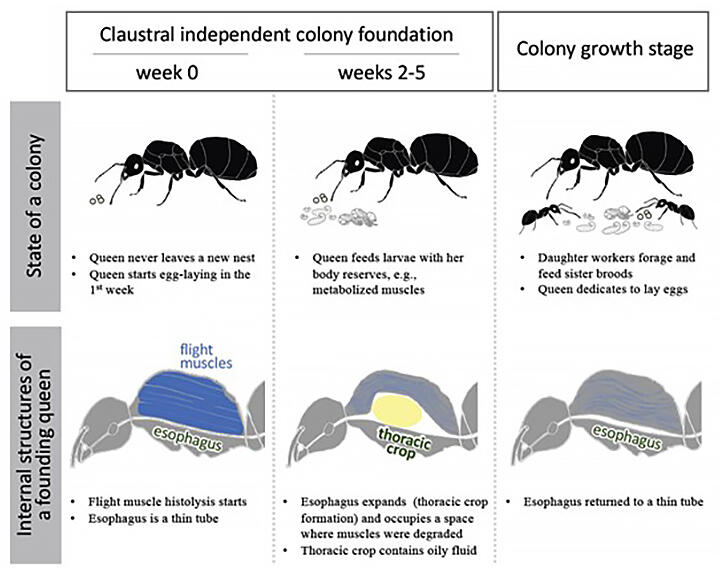How can queen ants raise larvae without foraging? A research group consisting of Associate Professor Satoshi Miyazaki of the Graduate School of Agriculture, Tamagawa University, and his colleagues, has clarified that when a Lasius japonicus queen ant independently founds a new colony, she raises her brood without any food, and that during the larvae-rearing period, part of her thoracic esophagus expands and forms a thoracic crop that stores liquid food for the larvae. The group also carefully investigated the formation process. Colony foundation by Lasius japonicus queens occurs in a form typical for ants, and so there is a possibility that this thoracic crop formation process is common to many types of ant. The group's research was published online in Arthropod Structure & Development.

Provided by Associate Professor Satoshi Miyazaki, Tamagawa University
Ants are social insects that build colonies consisting of a queen and workers, in which the workers are responsible for the work of rearing larvae and foraging. However, these roles differ only when a new colony is being established. Once copulation is finished, male ants die, and a single new queen descends underground, builds a nest, lays eggs, and brings up the hatched larvae as workers.
In the Ponerinae subfamily, which has primitive characteristics, the food given to larvae is gathered by the queen, who leaves the nest to get it, but it is thought that the queens of the Formicinae and Myrmicinae subfamilies, which are derivative groups, remain secluded in the nest and divert the muscle and lipids they have accumulated in their bodies to food for larvae-rearing, without eating or drinking. This latter strategy is known as claustral foundation and seems harsh at first glance, but it actually enables queens to avoid the risk of death outside the nest, such as from being preyed upon, and has made it possible for ants to spread into in many different environments.
There are several types of ant that engage in claustral foundation, and it is thought that during this process, the esophagus in the thorax expands into a pouch-like structure, forming a thoracic crop, and liquid food is stored here. Based on data indicating that the queen's fat levels decrease during this process, and that the now-unnecessary muscles used for flight are broken down, it is believed that fat and flight muscles are used for the food stored in the thoracic crop. On the other hand, there are ant species in which it is thought that the neutral fats stored in the gastral crop in the abdomen are refluxed and transferred to the thoracic crop. The formation of the thoracic crop and the storage of its content must play an important role in claustral foundation, but there are very few instances of researchers actually exploring these processes.
The research group carefully observed the processes involved in the formation of the thoracic crop in claustral foundation, focusing on new queen ants of the Lasius japonicus species, which are widely distributed in Japan. Lasius japonicus queens that have started claustral foundation begin to lay their eggs within one week. The first larvae are hatched by week two, pupate by week four, and the first workers emerge as adults in week six. In other words, the queen raises the larvae alone in the first two to five weeks of foundation. The group confirmed that, at the same time as this process, the queen's esophagus (a thin tube when the founding begins) starts to expand from week two, and grows into a pouch-like structure in weeks three to six, forming a thoracic crop. Moreover, flight muscle histolysis (break-down) occurs faster than thoracic crop formation in weeks one to three after foundation begins, supporting the possibility that the product from flight muscle histolysis is used as food. On the other hand, researchers did not see any striking size change in the gastral crop until week four after foundation began, and were not able to confirm if its content was refluxed to the thoracic crop.
When the group used a confocal microscope to observe the queen's thorax before and after thoracic crop formation, they saw that the esophageal wall is generally thick before thoracic crop formation, but the dorsal (upper) esophageal wall is particularly thick, with a minute, wave-like surface structure. Meanwhile, they learned that the esophagus of a queen in week three after foundation begins (when the thoracic crop has formed) expands on the dorsal side in particular, that it expands to occupy the space formed through flight muscle histolysis and that after this expansion the esophageal wall is stretched thin.
These outcomes indicated that thoracic crop foundation occurs during the same period as a queen is independently rearing larvae, that it is spatiotemporally coordinated with the histolysis of the now-unnecessary flight muscles, and that the structure of the esophagus is tailored to the formation of the thoracic crop. This suggests that both thoracic crop formation and the esophageal structure that makes this possible are what enable the harsh, one-ant larvae-rearing behaviour of Lasius japonicus queens.
Considering this research and past studies together, researchers believe that a thoracic crop forms in all species of ant involved in claustral foundation, especially Formicinae, through a process similar to that of Lasius japonicus. Moreover, during the process of this research, the group also saw larvae raised by the queen eating eggs and larvae that would be their sisters. Researchers do not know the extent of this cannibalism in claustral foundation, nor whether this is required behavior for claustral foundation. The research group wants to clarify the true state of one-ant larvae-rearing by queen ants by gaining a comprehensive understanding of this, too.
Journal Information
Publication: Arthropod Structure & Development
Title: Thoracic crop formation is spatiotemporally coordinated with flight muscle histolysis during claustral colony foundation in Lasius japonicus queens
DOI: 10.1016/j.asd.2022.101169
This article has been translated by JST with permission from The Science News Ltd.(https://sci-news.co.jp/). Unauthorized reproduction of the article and photographs is prohibited.




